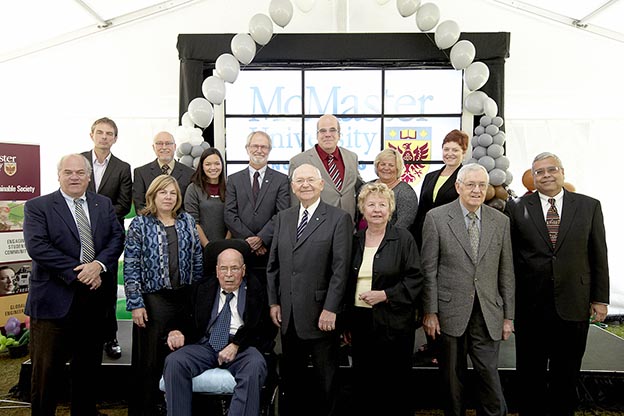$3M gift from Hatch allows student-focused engineering facility to move forward

Gerald Hatch (seated), founder and first president of the global consultancy, has joined with the company to commit $3 million to the Engineering Centre for Experiential Learning (ExCEL). Hatch and his team join a cadre of McMaster supporters to have made major contributions to the project.
A new centre that will foster experiential learning and collaboration among engineering students is set to go ahead after significant contributions from key McMaster partners, including a $3-million gift from Canadian-based engineering giant Hatch and its founder.
Gerald Hatch, founder and first president of the global consultancy, has committed $2 million to the Engineering Centre for Experiential Learning (ExCEL).
Kurt Strobele, chair of Hatch and a McMaster engineering alumnus, has committed $500,000 with a matching $500,000 from the company itself. The Hatch-related gifts will cover more than one third the cost of the $8.5 million project.
The University approval process is under way to have the ExCEL centre named in honour of Gerald Hatch, a celebrated metallurgist and multi-disciplinary consultant who became a member of the Canadian Science and Engineering Hall of Fame in 2011. Construction is expected to begin in spring 2015 and be completed by summer 2016.
“It gives us great pleasure to be able to support this project,” Hatch says. “We have worked to make Hatch a model of innovative thinking, and the concept of this centre is entirely consistent with the values that drive our company.”
Hatch and his team join a cadre of McMaster supporters to have made major contributions to the project.
Engineering students themselves are major partners, having committed $2 million when they voted in a referendum to contribute through a student levy.
Former Gennum Corporation CEO and President Doug Barber. a former professor of engineering physics at McMaster who also went on to serve as chair of McMaster’s Board of Governors, has made a $1.5 million gift together with his wife June Barber, a noted Hamilton-area potter.
Walter Booth – namesake of the University’s School of Engineering Practice – has made a gift of $1 million. Booth earned his undergraduate and master’s degrees in engineering at McMaster, and went on to become Chairman and CEO of the Timberland Group of Companies.
“This is a time for great celebration,” says McMaster University President Patrick Deane. “These generous contributions, coming as they do from some of the leading figures in Canadian engineering — and from Canada’s future leaders in engineering – both affirm and support McMaster’s role in setting the direction of engineering education.”
Students will be at the heart of the facility from the very outset, as the design process for the building – now under way – is to involve students working alongside engineering professionals to create the building design and the heating, cooling and other systems that make it run.
“McMaster engineering students will be involved in every level of this project, whose legacy will be to improve the experience and educational outcome for all engineering students,” says McMaster Provost and Vice-President Academic, David Wilkinson.
Once completed, the facility is to be a flexible space of about 25,000 square feet, adjacent to the J.E. Hodgins Engineering Building. There, engineering students will use assembly bays, workshops, boardrooms and other spaces to collaborate on research projects, community endeavours, clubs and activities, such as Engineers Without Borders and the Solar Car project.
The ExCEL Centre is to act as a living laboratory for students who will be able to draw lessons directly from the structure and its systems, which will be built with an eye to making their functions accessible to all.
“Students learn in many ways, and the ExCEL Centre will allow them to build and consolidate their learning through interaction and shared experiences, in a setting that exemplifies McMaster’s commitment to teaching and learning,” says Dean of Engineering Ishwar Puri.
The facility itself is to be built as a super-efficient building, drawing energy from geothermal and solar energy systems that will see it drawing minimal energy from the public grid.
Below, McMaster Engineering Musical helps celebrate the announcement with a special performance for guests outside of the John Hodgins Engineering Building.


